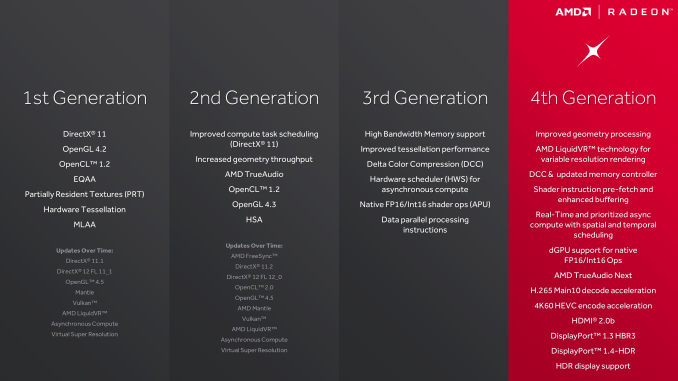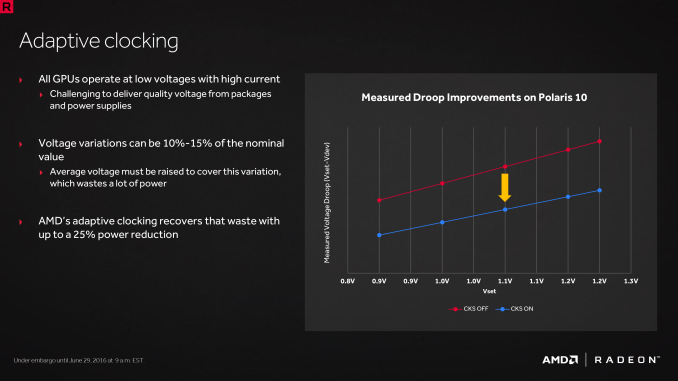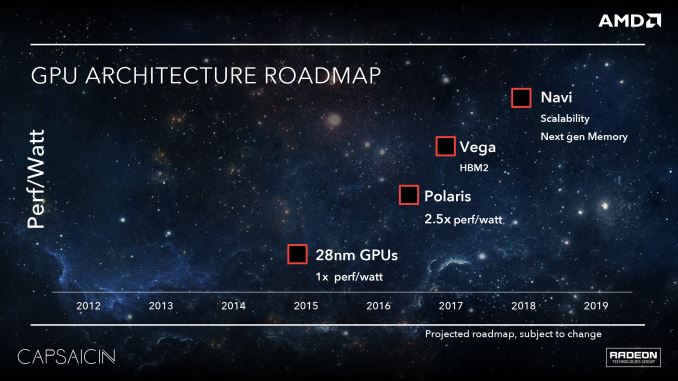The AMD Radeon RX 480 Preview: Polaris Makes Its Mainstream Mark
by Ryan Smith on June 29, 2016 9:00 AM ESTAMD's Path to Polaris
With the benefit of hindsight, I think in reflection that the 28nm generation started out better for AMD than it ended. The first Graphics Core Next card, Radeon HD 7970, had the advantage of launching more than a quarter before NVIDIA’s competing Kepler cards. And while AMD trailed in power efficiency from the start, at least for a time there they could compete for the top spot in the market with products such as the Radeon HD 7970 GHz Edition, before NVIDIA rolled out their largest Kepler GPUs.
However I think where things really went off of the rails for AMD was mid-cycle, in 2014, when NVIDIA unveiled the Maxwell architecture. Kepler was good, but Maxwell was great; NVIDIA further improved their architectural and energy efficiency (at times immensely so), and this put AMD on the back foot for the rest of the generation. AMD had performant parts from the bottom R7 360 right up to the top Fury X, but they were never in a position to catch Maxwell’s efficiency, a quality that proved to resonate with both reviewers and gamers.
The lessons of the 28nm generation were not lost on AMD. Graphics Core Next was a solid architecture and opened the door to AMD in a number of ways, but the Radeon brand does not exist in a vacuum, and it needs to compete with the more successful NVIDIA. At the same time AMD is nothing if not scrappy, and they can surprise us when we least expect it. But sometimes the only way to learn is the hard way, and for AMD I think the latter half of the 28nm generation was for the Radeon Technologies Group learning the hard way.
So what lessons did AMD learn for Polaris? First and foremost, power efficiency matters. It matters quite a lot in fact. Every vendor – be it AMD, Intel, or NVIDIA – will play up their strongest attributes. But power efficiency caught on with consumers, more so than any other “feature” in the 28nm generation. Though its importance in the desktop market is forum argument fodder to this day, power efficiency and overall performance are two sides of the same coin. There are practical limits for how much power can be dissipated in different card form factors, so the greater the efficiency, the greater the performance at a specific form factor. This aspect is even more important in the notebook space, where GPUs are at the mercy of limited cooling and there is a hard ceiling on heat dissipation.
As a result a significant amount of the work that has gone into Polaris has been into improving power efficiency. To be blunt, AMD has to be able to better compete with NVIDIA here, but AMD’s position is more nuanced than simply beating NVIDIA. AMD largely missed the boat on notebooks in the last generation, and they don’t want to repeat their mistakes. At the same time, starting now with an energy efficient architecture means that when they scale up and scale out with bigger and faster chips, they have a solid base to work from, and ultimately, more chances to achieve better performance.
The other lesson AMD learned for Polaris is that market share matters. This is not an end-user problem – AMD’s market share doesn’t change the performance or value of their cards – but we can’t talk about what led to Polaris without addressing it. AMD’s share of the consumer GPU market is about as low as it ever has been; this translates not only into weaker sales, but it undermines AMD’s position as a whole. Consumers are more likely to buy what’s safe, and OEMs aren’t much different, never mind the psychological aspects of the bandwagon effect.
Consequently, with Polaris AMD made the decision to start with the mainstream market and then work up from there, a significant departure from the traditional top-down GPU rollouts. This means developing chips like Polaris 10 and 11 first, targeting mainstream desktops and laptops, and letting the larger enthusiast class GPUs follow. The potential payoff for AMD here is that this is the opposite of what NVIDIA has done, and that means AMD gets to go after the high volume mainstream market first while NVIDIA builds down. Should everything go according to plan, then this gives AMD the opportunity to grow out their market share, and ultimately shore up their business.
As we dive into Polaris, its abilities, and its performance, it’s these two lessons we’ll see crop up time and time again, as these were some of the guiding lessons in Polaris’s design. AMD has taken the lessons of the 28nm generation to heart and have crafted a plan to move forward with the FinFET generation, charting a different, and hopefully more successful path.
Though with this talk of energy efficiency and mainstream GPUs, let’s be clear here: this isn’t AMD’s small die strategy reborn. AMD has already announced their Vega architecture, which will follow up on the work done by Polaris. Though not explicitly stated by AMD, it has been strongly hinted at that these are the higher performance chips that in past generations we’d see AMD launch with first, offering performance features such as HBM2. AMD will have to live with the fact that for the near future they have no shot at the performance crown – and the halo effect that comes with it – but with any luck, it will put AMD in a better position to strike at the high-end market once Vega’s time does come.













449 Comments
View All Comments
Demibolt - Friday, July 1, 2016 - link
Not here to argue, just fact checking.GTX 970 is currently in the top 3 cards used by Steam users (according to Steam's reports).
The GTX 970 can currently be purchased for ~$240 from several online retailers.
TimAhKin - Wednesday, June 29, 2016 - link
The 480 was never meant to compete with Pascal.This card is for people that want to upgrade from older GPUs. It's a pretty cheap card that's good for 1080p and VR.
Fallen Kell - Wednesday, June 29, 2016 - link
This is a horrible card for VR. It can barely do 60 FPS at 1080p, which isn't even in the same ballpark of doing the 90-120 FPS at 2160x1200 that is needed for VR. The card would need to be 3-4x higher performance than it currently is to pull off VR.Meteor2 - Wednesday, June 29, 2016 - link
No, you need 90 fps minimum for VR and the 480 does it at the resolutions used by the Rift and Vive just fine.DigitalFreak - Wednesday, June 29, 2016 - link
The 480 does 90fps @ 2160x1200? WTF are you smoking?Fallen Kell - Thursday, June 30, 2016 - link
I know, seriously. I don't know what Meteor2 or TimAhKin are smoking, as it is obviously the fanboy weed. There is only a single game that was benchmarked at 1080p where the 480 could even hit 90+ fps, and everything else was between 40-70 fps. And VR has 25% more pixels than 1080p.I mean, if the 480 was getting 120-130 fps at 1080p, then I would agree that it might be a decent VR card. But it averages about 1/3rd that on current AAA titles (or less with highest video quality settings enabled). This is why I said it needed to be 3-4x higher performance than what it is to do VR. Anyone using this for VR will have to turn down the video quality WAY down, which means you will see much more item/object popping due to object draw distances being so low, which destroys the immersion sense that VR is attempting to create in the first place. Add in the slideshows you will get during effects heavy scenes and get ready for the vomit comet to commence due to the eyes not seeing the results of your head moving.
Meteor2 - Thursday, June 30, 2016 - link
I'm going by the Occulus benchmarks. You know, the one by the people who make the VR headsets.killeak - Thursday, June 30, 2016 - link
Well, they said that this would be an entry level VR card, and for that I take using low settings but 90fps at VR Resolution, and I think it's possible to consider the RX 480 (just as the 970) an entry level VR card.Now, if we are talking high/ultra settings, then no, it won't make it.
pashhtk27 - Thursday, June 30, 2016 - link
And for 90fps on high settings, you have 1080. You sure should smoke cash.Yojimbo - Thursday, June 30, 2016 - link
You are looking at benchmarks with all settings maxed out. The RX 480 is entirely capable at running 90fps @ 2160x1200 with settings selected more judiciously.